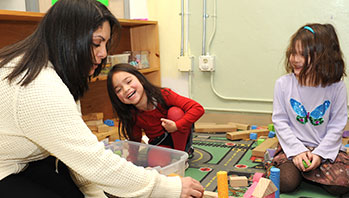- small familiar objects
- detective
- listen
- sound
- source
MA Standards:
Literature/RL.PK.MA.3: With prompting and support, act out characters and events from a story or poem read aloud.
MA Draft STE Standards:
Physical Sciences/PS4.A: Investigate different sounds made by different objects and different materials and reason about what is making the sounds. [Cause and Effect]
Head Start Outcomes:
Social Emotional Development/Self-Regulation: Follows simple rules, routines, and directions.
Approaches to Learning/Cooperation: Joins in cooperative play with others and invites others to play.
Approaches to Learning/Persistence and Attentiveness: Resists distractions, maintains attention, and continues the task at hand through frustration or challenges.
Logic and Reasoning/Reasoning and Problem Solving: Classifies, compares, and contrasts objects, events, and experiences.
PreK Learning Guidelines:
Science and Technology/Living Things and Their Environment 15: Use their senses of sight, hearing, touch, smell, and taste to explore their environment using sensory vocabulary.
Play Together: Sound Detectives

© Commonwealth of Massachusetts, Department of Early Education and Care (Jennifer Waddell photographer). All rights reserved.
STEM Key Concepts: Sounds have a source; Different objects make different sounds
ELA Focus Skills: Following Directions, Speaking and Listening, Vocabulary
Review how the children have been listening carefully to the sounds around them.
Tell them that you are going to teach them a game that will help them listen closely and become sound detectives. Ask a volunteer to help you demonstrate the game by standing and turning so his or her back is facing you.
- Hold up and identify three common objects, such as a sheet of paper, a stapler, or a dry leaf.
- Explain that you are going to make a sound with one of the three objects. Say, <Emilio> is the sound detective. He will need to listen very carefully so he can tell me which object the sound is coming from. Let’s try it.
- Demonstrate with one of the objects.
Now tell children it’s time for them all to become “sound detectives.” Give each child a chance to identify an object by listening to the sound it makes.
- Have children stand with their backs to you.
- Stand behind them and make a sound with one of the objects.
- Each time ask, What do you hear? What object do you think is making the sound? Explain that the object making the sound is the the source of the sound.
- What do you think I did to make that sound? Why do you think so?
- Have you heard the sound before? Where?
Social Emotional Tip: Help children understand that there are a lot of things they can learn—or help others learn—even when they are waiting their turn, so emphasize the need to be quiet, attentive, and respectful when it is someone else’s turn.
English Language Learners: Say aloud the vocabulary terms for the objects you are using before doing the activity. Ask children to repeat the terms after you. Then have children find some of the objects in the classroom. Ask them to point to the object and name it for you again.
